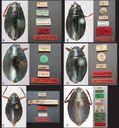Gyrinus
Gyrinus
Classification
- Phylum: Arthropoda
- Subphylum: Hexapoda
- Class: Insecta
- Order: Coleoptera
- Suborder: Adephaga
- Family: Gyrinidae
- Subfamily: Gyrininae
- Genus: Gyrinus
Pronunciation
How to pronounce Gyrinus: /dʒɪˈraɪnəs/
These audio files are automatically generated. While they are not always 100% accurate, they are a good starting point.
Images






Summary
Gyrinus is a genus of small aquatic whirligig beetles known for their spinning behavior on water surfaces. They are found in various aquatic habitats, predominantly in the northern hemisphere, and have a specialized sensory adaption that allows them to detect each other through surface vibrations.
Physical Characteristics
Small aquatic beetles that often exhibit a whirligig motion on the water surface. Specific physical characteristics such as size and coloration can vary among species.
Identification Tips
Look for their unique spinning behavior on water surfaces and their modified second antennal segment which they use to detect other beetles nearby.
Habitat
Aquatic environments, including ponds, lakes, and slow-moving streams.
Distribution
Widely distributed throughout North America, with over 30 species in Canada and 28 species in Michigan. Most species are found in the northern hemisphere.
Diet
Primarily feed on small insects and organic debris on the water surface.
Life Cycle
Details about their specific life cycle stages are not provided but generally include egg, larval, pupal, and adult stages typical of beetles.
Reproduction
Reproduction strategies are not detailed in the material provided.
Predators
Potential predators include larger aquatic insects, fish, and birds.
Ecosystem Role
Act as both predators and prey within their aquatic ecosystems, contributing to ecological balance.
Evolution
The genus Gyrinus belongs to the cosmopolitan tribe Gyrinini, which consists of this genus and two others.
Similar Taxa
Tags
- Gyrinus
- whirligig beetles
- aquatic beetles
- Coleoptera
- Gyrinidae